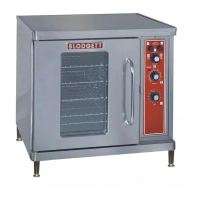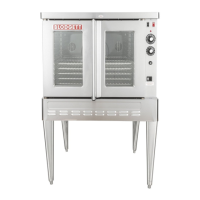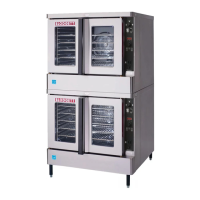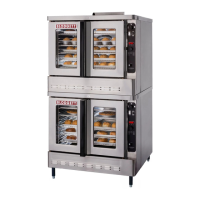MARK V
2-19
INTELLITOUCH - 19361 REV A
Component Reference
NOTE: Refer to FIGURE 9 page 2-20 for compoĆ
nent locations.
1. MODE SELECTOR SWITCH
2. COOLING FAN
3. DOOR SWITCH
4. STEP DOWN TRANSFORMER
5. INTELLITOUCH CONTROL
6. CONVECTION FAN
7. TEMPERATURE PROBE
8. CENTRIFUGAL SWITCH
9. ELEMENT CONTACTOR
10. HOT AIR ELEMENTS
11. 50 WATT LAMPS
12. LIGHT SWITCH
Operation
1. Turn the mode selector switch (1) to the cook
position. Power goes to the cooling fan (2), one
side of the door switch (3) and terminal #5 of
a 208/24 volt step down transformer (4). 24
volts are applied to terminal #T2 of the intelliĆ
touch controller (5).
2. If the doors are closed the door switch should
also be closed sending power to the convecĆ
tion fan (6).
3. On a call for heat, as sensed by the temperaĆ
ture probe (7), a set of contacts close between
terminals T2 and T5 sending 24 volts to one
side of the centrifugal switch (8).
NOTE: The centrifugal switch is a nonĆrepairĆ
able item. It is located in the convecĆ
tion fan motor. This switch closes when
the convection fan reaches full speed.
It is considered a safety switch and
should not be bypassed.
If the centrifugal switch is closed, 24 volts are
applied to the coil of the hot air element contacĆ
tor (9). When the contactor is energized, the
hot air elements (10) power up.
4. The 50 watt lamps (11) only receive power when
the light switch (12) is activated. These lamps
are 115 volt and are wired in series parallel.
NOTE: Turn the mode selector switch to cool
down to bypass the door microswitch. This
allows the convection fan motor to operate
even when the doors are open.
NOTE: This oven may be converted from single to
three phase, however, contactors must be
changed due to the difference in amp
draw. Reference detail inset in FIGURE 9.
NOTE: The resistive values for the probes used in
this oven have descending temperature
coefficients. As the temperature increases
the resistive values decrease.
NOTE: Reference page 4-2 of the TroubleshootĆ
ing section for the reistive values of the
heating elements. The reading should be
taken in a cold state.
NOTE: To calibrate the oven operation perforĆ
mance characteristics see page 3-8 of the
Calibration and Adjustment section.
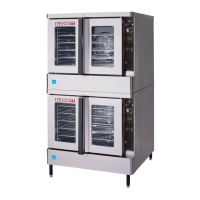
